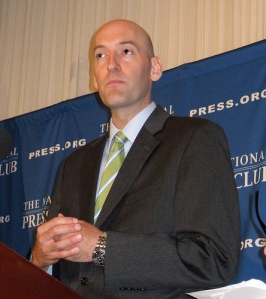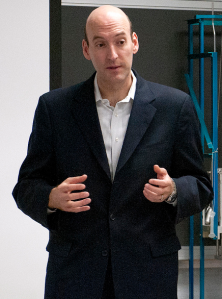Readers of this space know that the pace of safety reforms for America’s nuclear facilities, especially in the aftermath of Japan’s Fukushima disaster, has been alarmingly slow. The recalcitrance–if not active hostility–exhibited by the nuclear operators and their government handmaidens borders on the criminal. So, it might sound more than a little bit shocking to hear that the chairman of the Nuclear Regulatory Commission, Gregory Jaczko, is now under attack. . . for trying to implement new safety standards too quickly.
That’s not how House Oversight and Government Reform Committee Chairman Darrell Issa (R-CA) is putting it, of course. In doublespeak that would make Orwell proud, Issa has written to the White House, issued a report, and fallen just shy of calling for Jaczko’s head:
“The current Chairman, through his blatant disregard for the Commission and its core beliefs, is testing this resolve,” the report says. “The NRC has survived thus far but the cracks are forming and all symptoms point to catastrophe.”
The report comes several days after Issa released a mid-October letter from the NRC commissioners to the White House that alleges that Jaczko is causing “serious damage” to the agency that could harm the body’s ability to protect health and safety.
The reality, of course, is that Issa–who has summoned Jaczko and fellow commissioners to appear at hearings this very day–has a vested interest in obstructing new health and safety rules, and the hubbub and hearings he is now orchestrating do not in any way focus on post-Fukushima lessons learned, unless that lesson is that the nuclear industry must engage a full-court press to preserve their privilege and profits in light of a new global awareness of the true cost and real dangers of nuclear power.
Since taking the gavel at Oversight, Issa has used his authority to disrupt government’s regulatory roll in the service of his corporate benefactors. In the case of the nuclear industry, Issa’s district includes the San Onofre Nuclear Generating Station (SONGS), and Edison International, which owns nearly 80 percent of SONGS through its subsidiary, Southern California Edison, is Issa’s third largest source of career campaign contributions:
[Edison’s] political action committee has given Issa’s campaigns $46,000 over the years, including $5,500 during the last cycle. The PAC has also given $10,000 to Issa’s own PACs.
A company–in this case a nominally public utility–paying the piper and calling the tune is, sadly, not necessarily breaking news in 21st Century American politics, but when it comes to the nuclear sector, the level of influence and the nakedness of the quid pro quo should offend everyone.
And the ties don’t stop at the electoral level. Many regulators today come with strong connections to the industries they are supposed to regulate, but few demonstrate a closer relationship or a more unsettling affinity for their private-sector counterparts than NRC commissioner William Magwood, IV.
As reported in October, Bill Magwood, an Obama appointee, spent many years in the Bush administration’s Department of Energy as director of the Office of Nuclear Energy. During that time, Magwood was alleged to have had regular private meetings with Marvin Fertel, then-Senior Vice President and now President and CEO of the Nuclear Energy Institute (NEI), the lobbying arm of the nuclear power industry. (Not, coincidently, Fertel is quoted in several of this week’s stories hostile to Greg Jaczko.) FOIA requests were filed for records of those meetings, but Magwood’s email correspondence and calendars were destroyed just one month after he left the DOE in 2005.
After leaving the Bush administration, Magwood formed a consulting firm, Advanced Energy Strategies, which had as clients many of the nuclear power companies he dealt with at the Department of Energy and is now tasked with regulating as a commissioner at the NRC. One of those clients, as was uncovered this week by The Huffington Post’s Ryan Grim, was TEPCO, the Japanese power consortium that officially still owns and operates the damaged Fukushima Daiichi nuclear facility. And that’s not all:
Magwood’s recent client list makes up a who’s who of Japanese power and nuclear companies, and included CLSA Japan Equities Division, the Federation of Electrical Power Companies in Japan (FEPC), IBT Corporation, Marubeni Corporation, Mitsubishi Heavy Industries, RW Beck, Sumitomo Corporation and the Japan Atomic Energy Agency, which was roundly criticized for its response to the crisis.
It is Jaczko’s use of his authority to push for new rules based on the post-Fukushima Near-Term Task Force (NTTF) recommendations that reportedly triggered the discord that motivated Issa’s current attack. But the controversy is deeper and more complicated.
First, Magwood and other NRC commissioners were vocally differing with Chairman Jaczko before the Fukushima nightmare started. Most notably, some of the commissioners and much of the nuclear industry were upset when Jaczko removed the unfinished Yucca Mountain nuclear waste facility from the NRC budget after President Obama announced an end to the troubled Nevada dumpsite. Magwood was a strong proponent of Yucca Mountain during his years at the DOE and after, when he worked in the private sector. US nuclear facilities face a spent-fuel disposal crisis, and desperately need the federal government to take the hazardous waste off their hands.
Second, though the commissioners’ complaint was written and delivered to the White House in October, it was only made public by Rep. Issa last Friday. A slot usually reserved for news dumps seems like bad timing if Issa and his allies wanted to create a splash, unless you consider that Rep. Ed Markey (D-MA) had planned to release a report on Monday showing how NRC commissioners had coordinated with pro-nuclear legislators to slow or stop post-Fukushima safety reforms. Markey’s report (PDF) includes emails revealing commissioner Magwood and staffers for pro-nuclear Sen. James Inhofe (R-OK) worked together to discredit Jaczko for taking the lead on the US regulatory response to Fukushima.
Magwood, it should be noted, is thought to be next in line for NRC chief, if attempts to unseat Jaczko are successful.
Still, as internecine as all this sounds, this story would be easier to grasp if it were a simple tale of strong regulators vs. industry shills. Alas, as has often been the subject of these columns, the Jaczko-led NRC is far from the zealous industry antagonist depicted in pro-nuclear critiques. While Greg Jaczko might be the most regulation-friendly member of the current commission, his positions and policies are hardly progressive.
Those post-Fukushima recommendations, while all positive moves, are still weak tea when compared with the crisis that motivated the report. The speed at which they will be adopted–if they are ever adopted–can only be described as glacial. Despite Jaczko’s expressed wish that post-Fukushima realities be considered in the design, licensing and re-licensing of US reactors, the approvals of new construction and the renewals of operating licenses for aged reactors continue without any additional, Fukushima-influenced requirements. Further, disturbing domestic nuclear power events have not been met with the level of scrutiny they deserve.
November alone saw the approval of new reactors in South Texas, the refusal to consider the Fukushima report in the proposed relicensing of Seabrook, and reactor restarts of the quake-damaged North Anna facility and of the troubled Davis-Besse plant, even after its owner was forced to admit the presence of new cracks in its reactor building.
In October interviews, Jaczko expressed an interest in increased safety, but he also hid behind a regulatory process that quite plainly was not accomplishing his stated goals. The chairman also made assertions about the lifespan of reactors and the long-term safety of on-site spent-fuel storage that seemed cavalier and contrary to both existing evidence and current science.
While Jaczko might wish to see the Fukushima taskforce recommendations become rules, his pronouncements on the need for progress were weaker than the demands made by Sen. Barbara Boxer (D-CA) before her Environment and Public Works Committee (one of the committees charged with oversight of the NRC) during August hearings on the NTTF report:
The California Democrat said that if the industry wanted to operate and expand, it had to demonstrate that it could do so safely. Boxer stressed that it was important that citizens saw regulators as their defenders, able to act quickly in response to a crisis and honestly assure the safety of nuclear facilities. It takes a trusted regulatory regime for an industry to prosper.
. . . .
Boxer, to her credit, vowed to hold hearings every 90 days to push for action on the task force report.
The decision to stop construction on the Yucca Mountain waste facility, while the right one, was as much a victory for NIMBY politics as it was for progressive values. Indeed, Nevada Sen. Harry Reid (D), long an opponent of putting a nuclear dump in his state, was once Jaczko’s boss. The end of Yucca Mountain and Jaczko’s NRC job likely owe much to Reid’s early support of Obama in 2008.
Now Reid and Obama (through his Chief of Staff, Bill Daley) have come out for Jaczko again. But is this enough to counter the nuclear industry’s attempt at a coup?
While it would not be a surprise to see “no drama” Obama–who has benefitted greatly from nuclear industry campaign contributions–abandon his NRC chief, especially in the run-up to the 2012 election, it would be more difficult if anyone outside the Beltway felt moved to fight on Jaczko’s behalf.
It’s been the same story for Democrats for years now–Jaczko’s fight is just the latest example. Democrats from the president on down have repeatedly leaned right, disheartening and alienating their activist base, while gaining no measurable concessions from Republican opponents. Nothing Jaczko has done to appease the nuclear industry (or their government surrogates) has made them like him any more–to them, any regulator is a bad regulator. The nuclear lobby wants their loan guarantees, their tax breaks, and their Price-Anderson indemnity without any strings attached.
While it is very possible that any chair that replaces Jaczko will be even friendlier to the nuclear industry, there still exists little pro-Jaczko excitement on the left. Fukushima is a signal moment (well, in actuality, it is a never-ending series of signal moments), one that demands a much broader rethink of US nuclear policy than the regulatory tweaks in the taskforce report. If Jaczko and his elected allies want to energize America’s very-energize-able anti-nuclear community, then they need to seize the Fukushima moment with more than a proposal that better backup power systems be in place at some nuclear plants by 2016.
In the wake of the Japanese earthquake, the nuclear industry mobilized to secure their bottom line. Before there were recommendations to oppose, the industry had a plan in place to oppose them. If Jaczko and his backers want to see a mobilized response to this industry putsch, then they have to give people something to fight for. They can’t just make a few ripples and hope pro-nuclear forces will let it go; Jaczko, and Markey, and Boxer–and any others in government that grasp the meaning of nuclear’s “annus horribilis“–have to make waves.



You must be logged in to post a comment.